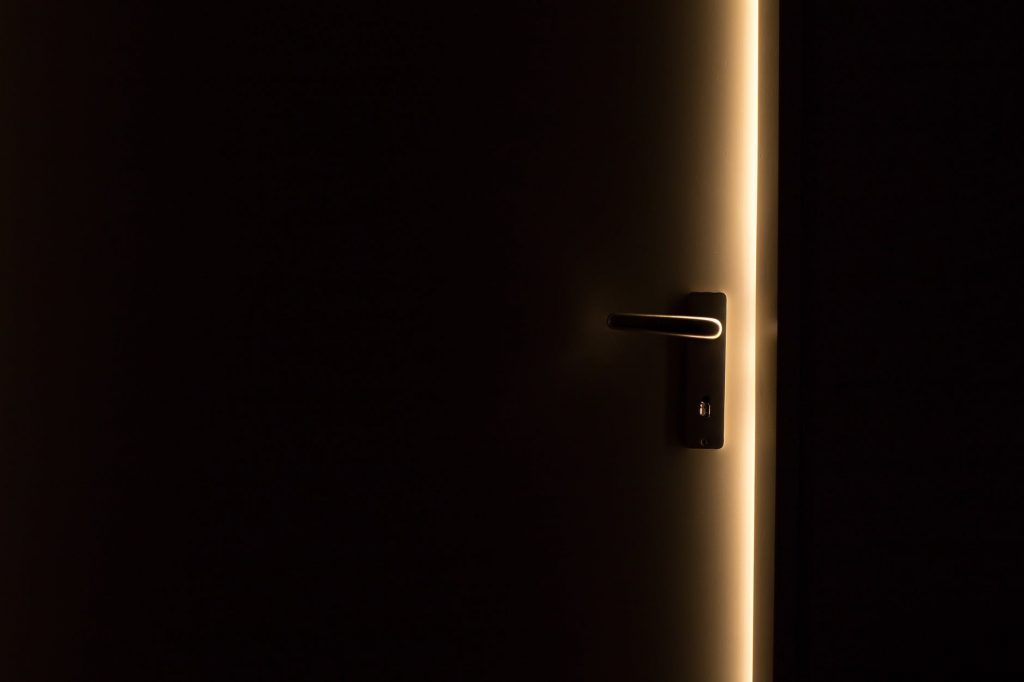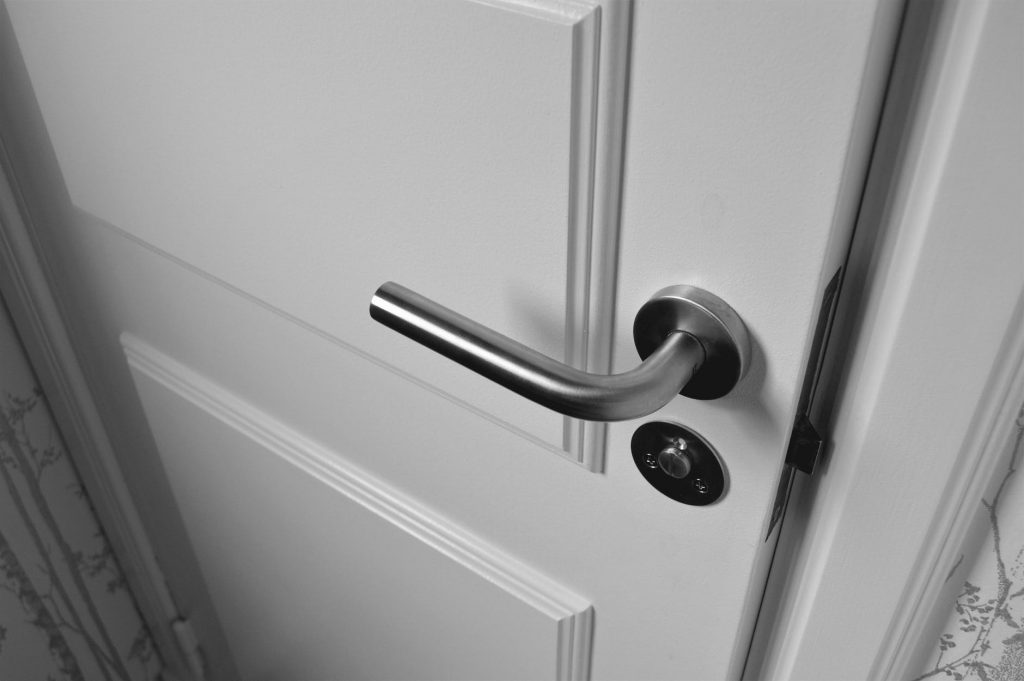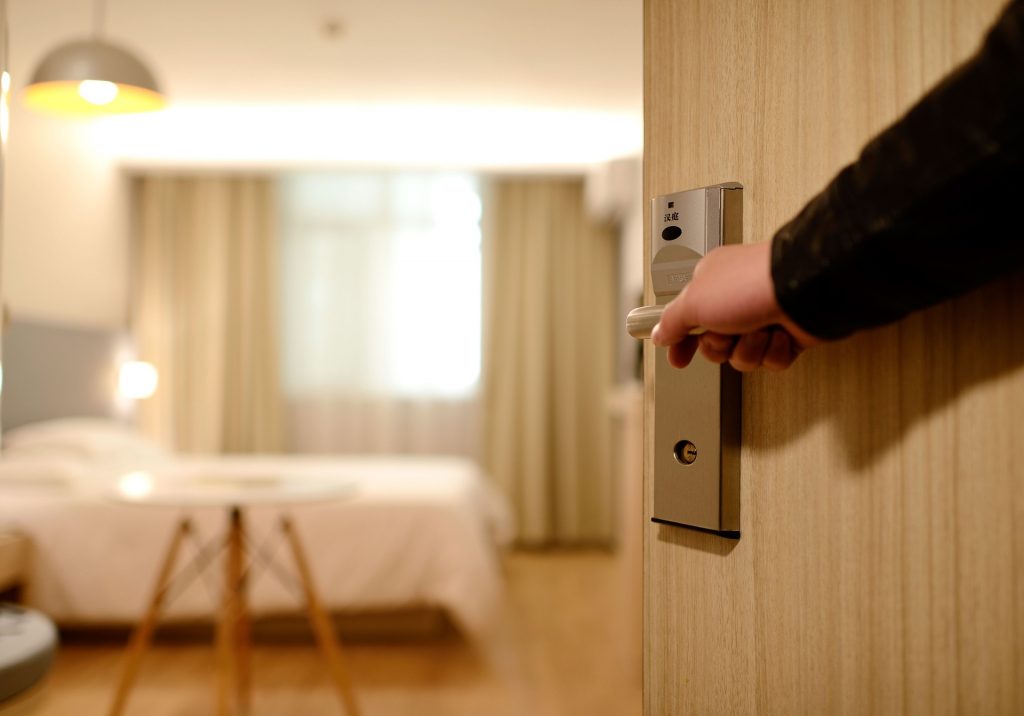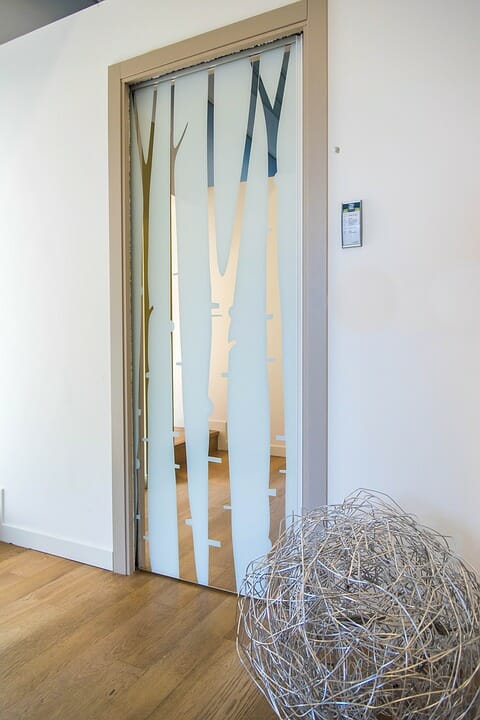How to Soundproof a Door
Soundproofing a door is actually a very easy thing to do – and probably not as expensive as you think. Nine times out of ten, simply sealing the air gaps around the door does the job very well. If that does not do the trick, don’t worry – we can build a custom acoustic panel to fit your door specifically to prevent even more sound.
Here are the two products discussed in this post: Door Seal Kits & Barrier Septum Fabric Wrapped Panels
_________________________________________________________________
C.S. writes:
My rented office space has a door to the adjoining office. The door, although closed, allows me to clearly hear all conversations in the next office and affords me no privacy for my conversations. The door frame has space on my side to install an acoustic panel. However, the landlord will not allow me to attach something permanent. Is there anything you recommend?
How to soundproof a door: at work, in your apartment, or in the noisy garage
The door is always one of the first places that I start to talk about when someone is concerned with the amount of sound entering or leaving a room. Like water, sound will travel via the path of least resistance, which almost always includes the spaces around the perimeter of a door. Combating noise in each of these situations looks just a little bit different. Whether you’re looking to soundproof an apartment door or office door, the attributes of each environment will determine how you tackle the noise pollution.

How to soundproof a door in your office?
When it comes to optimizing room acoustics in relation to doors, the perimeter of the door is always the first place I start when trying to help someone diagnose this type of acoustical problem. It is quite an easy thing to determine. The next time you’re in your office, ask someone to stand outside of the room and speak at a normal conversation voice level. Place your ear along the sides of the door, including the floor. If you can hear them clearly, ask them to lower their voice. Continue asking them to lower their voice until you can not hear them anymore. You will be surprised as to the amount of sound leaking out from around the seemingly invisible cracks in the interior door. If this becomes a problem, then you should look into installing a soundproof interior door to help employees maintain force and prevent disruption.
Locating the air gaps on doors
The first step in soundproofing a door for noise reduction is to eliminate as many air gaps as possible. A good way to locate air gaps is to turn the lights off in the office, and leave a light on in the hallway. Use a flashlight if there is no light in the hallway. Areas that leak the largest amount of light are also going to leak the largest amount of sound. You’ll want to focus your attention on those areas first.
How to efficiently seal gaps and cracks on your doors?
We have a line of products to eliminate air gaps, all of which are very easy to install and are fastened to the door or the jamb with small screws. Our Adjustable door seals can be ordered in a kit to seal up the gaps around the entire door, or each piece can be ordered individually. There are two different options to choose from and thickness relates directly to performance – the thicker the door seal, the more neoprene rubber that makes the seal. The correct thickness for any situation is a personal preference, and should be chosen based on the importance of confidentiality, as well as the severity of the problem you are experiencing.
 All of our door seal products are made from clear anodized aluminum with black neoprene gasketing. The adjustable Jamb Seal (Standard: 33C/Heavy Duty: 599C) will remain stationary and is installed up the two sides of the door as well as across the top of the door jamb. There are adjustment screws on the back of the unit, which allow the seal to be tightened or loosened in relation to the closed door frame. This ensures a perfect fit every time.
All of our door seal products are made from clear anodized aluminum with black neoprene gasketing. The adjustable Jamb Seal (Standard: 33C/Heavy Duty: 599C) will remain stationary and is installed up the two sides of the door as well as across the top of the door jamb. There are adjustment screws on the back of the unit, which allow the seal to be tightened or loosened in relation to the closed door frame. This ensures a perfect fit every time.
How do you soundproof the bottom of a door?
The bottom of the door is inherently the largest gap most people face. It has to clear the floor, so a gap is necessary. We have a very cool product that takes care of that pesky space. The automatic door bottom or door sweep is a self-leveling, spring-loaded mechanism that mechanically pushes a neoprene gasket to the floor as the door is closed. The seal on the hinge side of the door will hit the ground first, and the seal becomes more level with the ground as you close the door, preventing wear on the neoprene seal. When the door is opened, a spring inside the unit pulls the seal up away from the floor. If your door swings into the room, the door seal will need to be installed on the hallway side of the door. If your door swings out of the room, you will install the door seal on the room side of the door.
Can I use the automatic door bottom on the carpet?
You can use an automatic door bottom, but using it on a carpet doesn’t yield the best results. I would not recommend this for two reasons. First, the door seal will perform best if it has a solid surface to seal onto. The carpet does not provide this. Second, if the neoprene is constantly coming down to and running across the carpet, the neoprene will wear out very quickly.

How do you soundproof a hollow core door?
If you have a hollow-core door, the door seal may not be enough. This is due to the gaps inside the door. A hollow door can’t block that much sound. We can build a custom acoustical panel that will increase the mass and density of the hollow door to help in these cases. Our Barrier Septum Fabric Wrapped Fiberglass panels are custom made on a per-job basis. These types of acoustic panels have a center layer of 1/8″ thick, 1lb per square foot Mass Loaded Vinyl Noise Barrier which is a product specifically designed to block sound.
How to soundproof doors using panels?
This panel will be fabricated specifically to the measurements that you provide, and faced with the fabric of your choosing. We can pre-fabricate the panel with a doorknob hole if needed, or one can easily be installed when the panel gets to the job site. These acoustic panels are typically either adhered to the exterior door with a construction grade adhesive, or bolted to the door with screws. For an installation that can be removed, we can install a two-part E.C. clip where one side of the clip is screwed to the door and the other part of the clip is screwed onto the back of the panel during fabrication. The clips are like a very industrial picture hanger. Photos of the clips can be found on the Fabric Wrapped Fiberglass panel spec page – toward the bottom. Please keep in mind that these panels are heavy, which is part of the reason why they are so good at stopping sound.
How much does it cost to soundproof a door?
The door seals range in price depending on the size of the door and which option (standard or heavy-duty) you choose to purchase. The price range for the door kits is between $247.00 and $470.00 plus shipping. The fabric wrapped fiberglass panels are priced on a per-job basis because they are all custom made. Ballpark pricing for the panels is around $14.00 per square foot, and does not include shipping. A panel for a standard 3′-0″ x 7′-0″ door would be around $300.00.
Bonus FAQ
Can you soundproof a bedroom door?
Your bedroom is the place you go for rest and relaxation. But it can be tough when you have an abundance of noise coming through the door. Noise from the kitchen or living room could distract you from getting quality rest. The most logical thing would be to install a soundproof door to your bedroom from the start. Yet, what if your landlord doesn’t want dramatic changes on his property, or your budget doesn’t allow for it? There are certain things you can do to ensure a good night sleep and quality rest. Of course, you could start with furniture arrangements, like placing bookshelves around the door and moving your bed at the opposite side of the room, investing in a thick rug, etc. But, in the end, this might not get you where you want to be.

Here are some possible solutions:
- An acoustic curtain or blanket is a great option not just for silencing rooms, but they also help conserve energy. There are some other useful options like installing adjustable door bottoms and adding adjustable door stops that may be helpful. Another thing that could be useful is to add a thick layer of acoustic foam to your bedroom door.
- Another important aspect when it comes to creating your oasis is to get soundproof windows. Just like all the acoustical solutions we mentioned above – utilizing window inserts won’t change the appearance, they will just help with eliminating traffic and other types of outside noise.
How to soundproof a home office or studio?
These days, a lot of people started working remotely. For some, it was a reality way before this situation began. If you own a home office, a recording studio, or even a small space where you record a podcast – you know that setting a quiet environment plays an integral role. Maybe you are a doctor or dentist working from home. Your family is living their own lives and routines, but you need to focus on your work. Your needs are a bit different. Quality carpets or soundproof curtains will help a lot, but the best thing you can do is opt for soundproof door installation.

How to soundproof a sliding door?
Sliding doors are an amazing feature for your home and your office. Sliding doors are not just decorative. They give you plentiful natural light, which can help lift your spirits. Yet, sliding doors are a bit of a different story when it comes to soundproofing and noise reduction. They are a big source of outdoor noise, like dogs barking and traffic. There is also something called the impact noise which occurs when something hits the sliding doors. It makes your interior door vibrate, which adds to the noise. If you want to prevent this without changing the glass, which is really expensive, a great solution is utilizing soundproof blankets and soundproof curtains. During winter months, this can also help you save on electric bills. If you want to keep the appearance intact and continue enjoying the beautiful sunshine, use the Acoustic Series window inserts designed with aesthetics and practical use in mind.

How to soundproof a garage door?
Garage doors are an entirely different story. They produce noise on so many levels. Garage door motors are a great source of the noise in many homes because the vibration is emitted to the second floor. In this case, soundproofing is very important. Our garage door soundproofing kit may be just the ticket to solving your garage door noise. This system eliminates hard surface to surface contact, which happens when the motor and the rails are in contact. If you want to add an additional layer of protection for the unwanted noise – make sure to add soundproofing panels in the garage and install soundproof flooring as well. For example, our echo eliminator composite panels or sound silencer can help with protecting your home from rampant garage door motor noise. If you have a trickier situation, we are always here to help. Contact us today.



